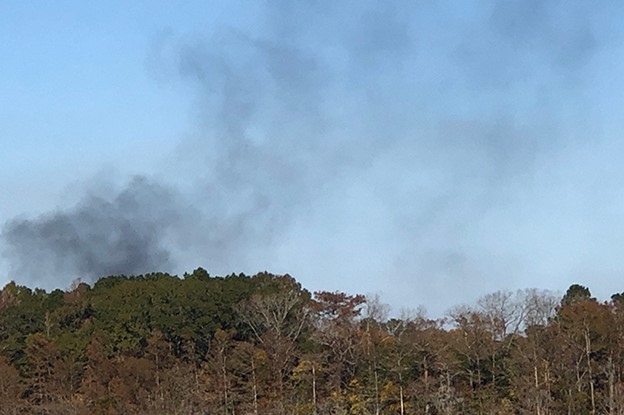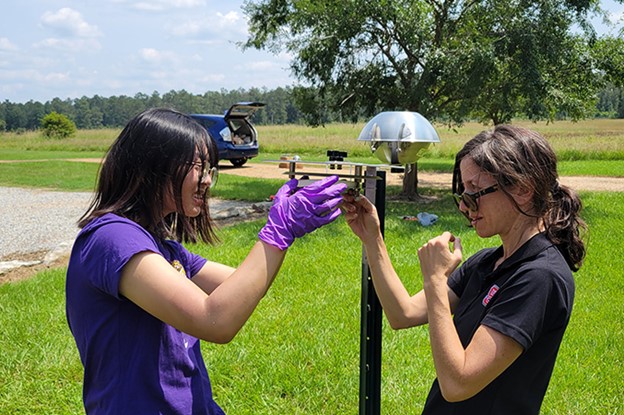LSU SRP Study Provides Crucial Community-level Information on Air Quality and Health
LSU SRP researchers are working with community members to understand the impacts of air pollution in Colfax, Louisiana, which is located near Clean Harbors Colfax, a commercial open burn/open detonation thermal treatment facility that processes a range of hazardous waste materials, including from Superfund sites. The latest issue of the National Institute of Environmental Health Sciences’ Partnerships for Environmental Public Health Newsletter features LSU SRP researchers’ work using combined mapping of community interview data and quantitative pollution models to understand the spread of air pollution and its effects.
Read the full Partnerships for Environmental Public Health Newsletter article here.
Jennifer Richmond-Bryant, PhD, Leader of the LSU SRP “Hazardous Waste Thermal Treatment and Community Exposure to Environmentally Persistent Free Radicals” project and Associate Professor of the Practice in the Center for Geospatial Analytics at North Carolina State University, is the first author of the study, and LSU SRP team members Jennifer Irving, MPH, LSU SRP Research Translation Coordinator and graduate student in LSU’s Department of Environmental Science; Chuqi Guo, PhD, LSU SRP trainee and postdoctoral researcher; and Margaret Reams, PhD, LSU SRP Community Engagement Core Leader and Professor in the Department of Environmental Sciences at LSU, are among the co-authors.
Their study combines qualitative and quantitative information to analyze air pollution exposure impacts in the low-income, majority-Black Colfax community. These researchers’ mapping of data from different sources shows that community reports of negative health and property impacts correspond to quantitative air pollution dispersion model output and known health effects of the chemicals being burned. Commenting on this study, Dr. Richmond-Bryant noted,
"Our work has helped to validate the community members’ narratives about health and environmental effects experienced."

Heatmap indicating the geographical distribution of reports of respiratory disease around the Clean Harbors Colfax facility (the red plus sign indicates the location of the burn site), with yellow indicating the highest concentration of reports and blue indicating lower concentrations. Concentric red circles are at approximately 3-mile intervals, and self-reported respiratory disease is indicated by red dots.
In spring and fall 2022, Dr. Richmond-Bryant also led the creation of two LSU SRP Community Engagement Core reports on preliminary findings about air quality and health for distribution to Colfax community members. Explaining that this step is a planned part of the iterative community-integrated research process, Dr. Richmond-Bryant commented that “Our study design was based on community input, and the air pollution data we collect can then be given to the community members to empower them with the data behind their claims.”
A community report distributed in March 2022 provided residents with local maps illustrating how far pollution from the Clean Harbors Colfax facility likely travels into their communities and presented details on the amount of waste and types of materials burned. The models show that the pollution, at times, is expected to extend beyond 25 miles away from the facility, with the highest levels within 1 to 3 miles of the facility. The model also shows the highest emissions in spring and summer. Finally, the report summarized analyses of community interviews and public hearing comments, mapping reports of health problems in relation to the Clean Harbors Colfax facility. Specifically, the report mapped thyroid disease, skin damage, breathing problems, and cancer and summarized research findings linking specific chemicals found in the waste burned at Clean Harbors Colfax to these and other health outcomes.

View from the Colfax community of smoke produced by the Clean Harbors Colfax facility.Brenda Vallee
The fall 2022 report, distributed to community members in September, shared an overview of the different steps in the study timeline and presented the preliminary findings to date. In this report, the Community Engagement Core also described the three types of samplers set up in the area (high volume, passive, and electronic samplers), their purposes, and their locations. The report further summarized some of the chemicals present in waste exploded at Clean Harbors Colfax and their major health effects and illustrated computer model predictions that show—contrary to Clean Harbors Colfax’s repeated claims that no pollution travels outside their facility—that the pollution plume travels at least 20 miles away, covering many homes in the community. Preliminary results presented from the samplers show that the pollution concentration in the air in these communities was frequently high enough to be hazardous over time. The analyzed samples in a preliminary group of locations show the presence of environmentally persistent free radicals and small metal particles, both of which are particularly hazardous to human health.

LSU SRP team members Dr. Chuqi Guo (left) and Dr. Jennifer Richmond-Bryant (right)
install a passive air quality monitor on the property of a Colfax community member.Jen Irving
As a next step, after the outdoor air pollution sample collection campaign is complete, Dr. Richmond-Bryant’s team will be collecting and analyzing dust from community residents’ homes.